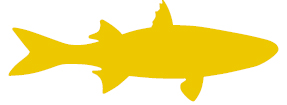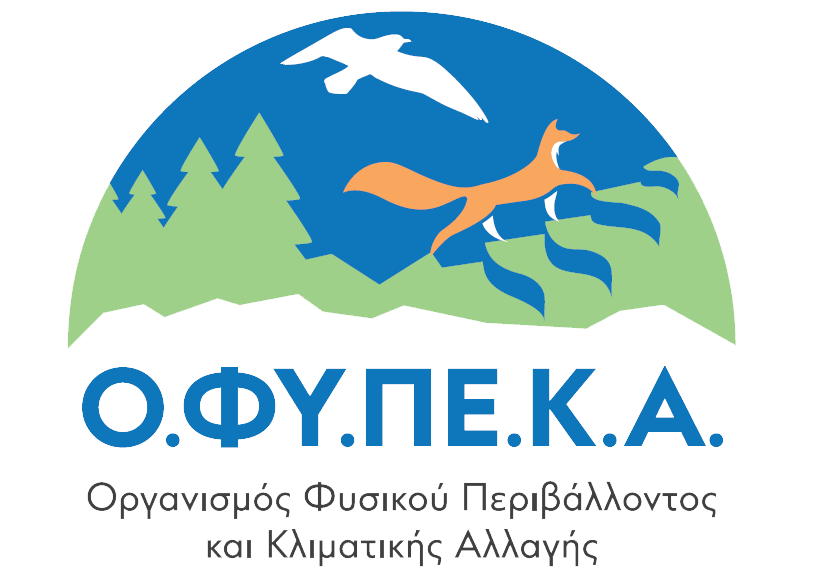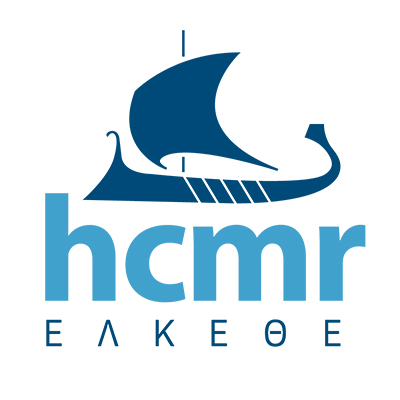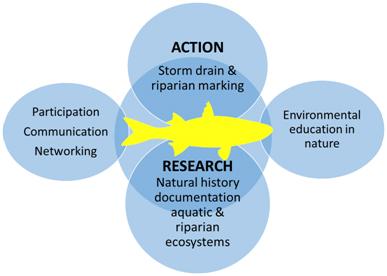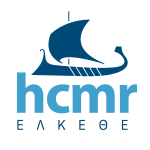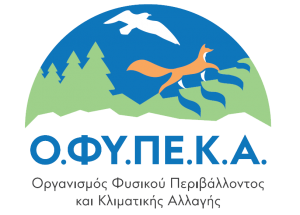SHORT SUMMARY
The Yellow Fish is a painted fish symbol you might see next to storm drains near streams and lakes in and near cities. It is very widely used as a “storm drain marking campaign” to increase awareness and protect waters from diverse forms of pollution; it is especially popular in North America. Recent reviews show that since the late 1980s it has been implemented as an education and pollution abatement campaign in over 40 states and provinces in North America and in several other countries, including the UK, Australia and Korea. Storm drain marking is a volunteer effort and is especially popular among youth groups, schools and education programs. The symbol of the fish – as a warning sign- seems to be an effective “environmental cue” in order to increase public awareness of “living waters”; their health, natural history and protection in and around cities.
Here we summarize our experience in introducing the Yellow Fish campaign for the first time in Greece. The collaboration was set between Greece’s largest public aquatic research institute, the Hellenic Centre for Marine Research (HCMR) and the Natural Environment and Climate Change Agency (NECCA), a legal entity of private law supervised by the Hellenic Ministry of Environment and Energy (MEEN). The project begun on the 26th of June 2019 and ended on the same day in December 2020. At HCMR the work was coordinated by the inland waters section of the Institute of Marine Biological Resources and Inland Waters (Inland Waters Section). HCMR will maintain the project website at least until December 2023 and it will assist in collaborating for the further promotion of Yellow Fish storm drain marking campaigns and associated research, immediately after the COVID-19 pandemic subsides.
The campaign development in Greece is a four-pronged initiative aiming at: a) introducing the ACTION of storm drain marking, b) combining the action with ichthyological conservation-relevant RESEARCH, c) promoting experiential environmental education in nature (“in-stream” natural history-based education) and, d) promoting greater communication -participation-and networking among participants.
THE MAIN ACHIEVEMENTS IN GREECE SO FAR
- Website. A dynamic website was completed to host the results of this project and to provide an ongoing communication and participatory platform for future Yellow Fish campaigns. A novelty within the site is the geo-tagged underwater video collection (where participants can send their underwater videos to be showcased and mapped). The site also is associated with the questionnaire and participant feedback. The site is meant to promote Yellow Fish, urban and peri-urban water body natural history and citizen science, and activism through social media (including through the Yellow Fish GR facebook and tweeter accounts). HCMR personnel will monitor the site until December 2023 to assist groups in taking up Yellow Fish campaigns.
- Storm drain marking event and field seminars. Students and secondary school teachers participated in a storm-drain marking educational event at the Rafina Megalo Rema stream (Attika) with students participating from the middle school and high school of Rafina (30 participants on 13.06.2020). The event introduced participants to the Yellow Fish idea and to experiential guided experiences in an urban stream. All participating students gave positive support and good feedback. Students felt they were contributing (participating in a type of “graffiti” of shorts). A type of activism: Students felt pride in the final “artistic” product, the stenciled Yellow Fishes – their signature of commitment to stream conservation. At Rafina, storm-drain marking was combined with a stream visit. Everyone was encouraged to enter the water – using wellington-style boots- to stroll freely in the shallows. It was very important to combine the storm drain marking effort with experiential education in the waters. Two more seminars with reference to urban/peri-urban stream conservation took place on field trips with post graduate students to Pikrodaphne Stream (10.03.2020) and Vravrona Wetland (13.09.2020). Other field visits employed a few student volunteers at sites near Athens such as Schinias-Marathon National Park (this was combined with ichthyological research and documentation technique development – see icthyological research below).
- Standardizing the Yellow Fish stencil and storm drain marking. The specific standardized stencil was created for Yellow Fish in Greece: it depicts a flathead grey mullet (Mugil cephalus), a common and widespread inhabitant of lowland streams, wetlands and coasts in Greece. In order to maintain “brand continuity” – most items created in this project show-case the yellow fish stencil symbol (the colours of the yellow fish are yellow with blue around it). Stencils were produced and provided to the Rafina Middle School and High Schools in June 2020 and the research became a report-focus for students enrolled in a Masters level project at the National Technical University of Athens. The Yellow Fish project originally conceived of storm drain marking many sites in Greece (at least 50); many potential sites were visited during the guided seminars and icthyological research (see below), but due to Covid-19 pandemic conditions, it was not possible to mark sites beyond the initial work at the Rafina Megalo Rema river. HCMR plans to continue stream marking events after the pandemic subsides.
- Graphic art for promotion. Part of the project was based on a promotion campaign; simple graphic art and advertizing approaches were employed for effective science and conservation communication. A series of logo-stickers (featuring the yellow fish symbol), knowledge-posters (photos with slogans) and a power point presentation were created as advertizing material (housed in the website) and destined for initiating campaigns in social media.
- Ichthyological research in the Western Aegean Ecoregion. The project had a research component focusing on fish distributional research in urban and suburban areas especially, in Central Eastern Greece and Attika. During the project period 67 sites were researched using electrofishing and other collecting methods. New discoveries of fish distributions were made (a scientific paper is being drafted with support from this work). A summary report was produced from the results of the research and is available in the project website. In some field visits university students volunteered to participate in the field surveys – and they received training and participation experience.
- Yellow Fish manual. A manual was published on-line to assist teachers, conservation practitioners and students of all levels in developing a Yellow Fish campaign. The illustrated manual is 65 pages long and includes: the stencil, specific directions and details of storm drain marking, a glossary of relevant terms and supportive bibliography.
- Mini-Documentaries and underwater video promotion. Two instructive video spots were created. The first is an introductory piece (03:20.mins) announcing the Yellow Fish project; the second focuses on the experiential educational activities and the aquatic biodiversity of streams in and near cities (06:02.mins). Since video is now widely used in social media especially among the youth, a special effort to promote underwater video was attempted. The website holds an interactive map where videos will be uploaded from interested members of the public (communicated through a special form sent to the website’s email). HCMR personnel tested various ways of “sampling” underwater environments using action cameras (GoPro and others). The first results are impressive and many interesting aspects of underwater life are recorded easily and rapidly (and this can be done by citizen scientists). Training guidance and instruction to use action cameras to record underwater video is provided in the project website.
- Monitoring and assessment of the project. A questionnaire was developed and placed on the website in order to explore citizen involvement in stream conservation and their awareness of storm-drain pollution issues in Greece. The results from this initiative will be analyzed and published in the future.

LOGISTICS AND OTHER DETAILS
Project costs and investment
The project was contracted to HCMR and begun on 26th of June 2019, ending on the same day in December 2020. The project was awarded with 19,999 € (excluding VAT) to HCMR by the National Center for Environment and Sustainable Development (NCESD). The NCESD morphed into the National Center for Environment and Sustainable Development (NECCA) after the enactment of a new Environmental Law by the Hellenic Government in May 2020.
The funds from this project were used by HCMR to cover specific research costs, contracting scientists and artists, purchasing and renting scientific equipment and travel to research sites and campaign events.
Participants and acknowledgements
The following members of HCMR participated in this project:
Permanent HCMR staff involved in this project include:
Stamatis Zogaris (Geographer-Biologist – Principle Investigator of the Yellow Fish project), Sofia Giakoumi (Ichthyologist – Coordinator of the Yellow Fish project), Elias Dimitriou (Geologist-Hydrogeologist), Ioannis Karaouzas (Biologist), Eleni Kalogianni (Icthyologist), Roberta Barbieri (Icthyologist), Sofia Laschou (Chemist), Argyro Andriopoulou (Biologist), Maria Koutsodimou (Biologist), Theodora Kouvarda (Environmental Scientist).
HCMR contractors involved in this project (on a volunteer basis) include:
Emilia Panagiotou, Anna Latsiou, Nicholas, Koutsikos, Theocharis Vavalidis, Dimitris Kommatas, Yiannis Kapakos, Aikaterini Patsourakou, Ioannis Leris, Manos Sperelakis, Stella Ioannou and Nick Providakis.
Web design and web master support was by Stella Ioannou (HCMR in-house).
Video production and main videography was by Nick Providakis (HCMR in-house).
Graphic art, web-site support, e-book production was by Aris Vidalis (ARVINAT Ltd).
Volunteer researchers in this project also include: Vassiliki Vlami, Dimitris Zogaris, Radek Sanda, Jasna Vukic.
Principle photographers in this project include: Nick Providakis, Aris Vidalis, David Koutsogiannopoulos, Yiannis Kapakos and Stamatis Zogaris.
The Committee for approval and completion at NECCA:
Kostas Triantis, Panayotis Dimopoulos and Petros Varelidis
Acknowledgements
- HCMR wishes to thank Zoi Vrontisi (NCESD) and Aphrodite Rouvali (NCESD/ NECCA) for support of this project. Special thanks for specific contributions to Petros Varelidis (NCESD/ NECCA).
- For support with work at the Rafina Megalo Rema stream we thank Antonis Lazaris (Biology High School teacher) and students of the 1st Middle School & High School of Rafina.
- Andreas Vassilopoulos and Valerie Vassilikos at Rafina.
- Maria Trivourea at the Management Body of Schinas-Marathon National Park for all support and the synergies among other on-going projects.
Anastasios Stamou, National Technical University of Athens (contribution in Master’s Level student research).

FINAL THOUGHTS AND RECOMMENDATIONS
Yellow Fish campaigns for both storm drain marking and environmental education initiatives seem to be worthwhile effort and should be promoted and further tested for their communication and conservation effectiveness. Much needs to be done for urban/suburban water body awareness and appreciation in Greece; the issue is overlooked and neglected. HCMR’s Education Unit will continue to promote and use the Yellow Fish brand, the stencil drain marking and to research the effectiveness of this initiative. During the current project we have developed the first structured action of this kind in Greece and are eager to continue the work. We urge that storm drain marking be implemented within a holistic urban water awareness scheme and not be used solely as a mechanistic storm drain marking exercise. The value of the exercise is compounded when experiential educational, research activities and science communication are incorporated in the action. Incorporating natural history awareness is very important in conservation and management in urban/peri-urban streams. HCMR researchers are open to further collaboration on promoting Yellow Fish in Greece and abroad. For further information and updates please visit: http://yellowfish.hcmr.gr/
